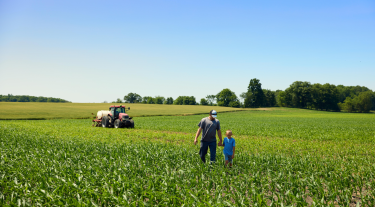
CHALLENGE
How can a nutrition company become more resilient in a time of transformation?
For many across the food chain it is clear: climate change is disrupting global food production. It makes the transition to more sustainable, resilient food systems all the more important. Yet, where do you begin?
As a global nutrition company, Glanbia wants to support a resilient food system. Its operations are home to performance nutrition brands like Optimum Nutrition and Isopure, promising to deliver better nutrition for a better world. Sustainability and climate resilience have a large role to play in delivering this promise.
Glanbia acknowledged that it needed to analyse its climate risks and opportunities to focus its internal strategy where it could be most impactful. In addition, the company needed to disclose to stakeholders how it is tackling the climate challenge and is building on the opportunities of a Net Zero transition. Recognising the opportunity to go beyond compliance, Glanbia wanted to assess its impact on the climate as well as the climate’s impact on its business. Doing so would form the basis for a transition plan; one that would turn decarbonisation levers for the supply chain into clear action.
Climate reporting standards
Reporting on climate-related risks and opportunities has become a legal requirement or, at the very least, expected best practice. One of the most recognised climate reporting methodologies is the TCFD framework (Task Force on Climate-Related Financial Disclosures). It forms the basis and has been built on by other disclosure initiatives or standards, including:
CDP: A voluntary framework for climate disclosures.
CSRD (Corporate Sustainability Reporting Directive): Rolled out by the EU in 2024, CSRD requires companies to report how sustainability issues impact their business and how their operations in turn affect people and planet – a unique principle called ‘double materiality’. What this means for businesses.
ISSB (International Sustainability Standards Board): In 2023, the ISSB, which is part of the International Financial Reporting Standards (IFRS) Foundation, published its standards on sustainability-related disclosures. The standards aim to create a global baseline for sustainability reporting. Many jurisdictions are planning to adopt ISSB-based standard, including Canada, Singapore and the UK while others, including Brazil and Nigeria, have already adopted the standards.
SOLUTION
Delving into Glanbia’s climate risks and emission profile to inform a transition plan
A transition plan requires businesses to take a holistic approach. First, they need to have a clear overview of their carbon intensity alongside their risk exposure to address emissions hotspots and weak points. In the case of Glanbia, this meant looking at the company’s full value chain, particularly its dairy supply. Having worked with Glanbia since 2017, we:
IMPACT
Making the financial business case for climate action
The deep insights into Glanbia’s risk profile, carbon footprint and opportunities to reduce emissions, empower the company to go beyond mere reporting. Instead, the insights have given Glanbia the building blocks for a transition plan and the costs required. Glanbia now has an opportunity to set the bar on decarbonising dairy as it begins to:
1 Using the results from Glanbia’s US partner, Newtrient, we reviewed the carbon intensity of individual farms across Idaho on Glanbia’s footprint. From this, we identified a set of interventions per farm.








